The tank has long been a staple of combat
in the Middle East. It featured prominently in the North African campaign of
World War II and in every major clash between Israel and its Arab neighbors
since the Jewish state declared its independence in 1948.
Even today, it is the heavily armored main
battle tank (MBT) that stands watch along Israel’s border with Lebanon and is
the first line of support for infantry patrolling the Palestinian territories.
Across the Arab World, the tank remains central to war fighting doctrine and the
weapon of choice for commanders wishing to seize and hold ground in virtually
all battlefield conditions.
Yet despite this record of distinguished
service, there are those in the military community who contend that the era of
the tank is rapidly fading. They point to dramatic advances in anti-tank guided
missiles (ATGMs), improvised explosive devices (IEDs), anti-armor mines,
refinements in close air support and the proliferation of unmanned vehicles as
evidence that a global revolution in ground combat is now underway.
For many, this means a gradual move away
from the large and expensive weapons platforms that have long dominated modern
warfare and towards more nimble, less expensive fighting vehicles. What these
new systems lack in firepower and protection their designers insist is made up
for in stealth, range and operational flexibility.
Even in Great Britain, home of world’s
first tanks, the Ministry of Defence (MoD) is now reevaluating the place of
tanks in the Army’s order of battle. With budget cuts looming, the MoD is
shifting its focus away from traditional armored platforms and towards an array
of multi-role weapons, rapidly deployed forces and improved surveillance
systems. According to a recently released White Paper, this could mean the
elimination of two armored regiments and nearly one third of the country’s heavy
armored force, approximately 120 Challenger 2 tanks, over the next several
years.1
The lessons now being learned by Coalition
forces in Afghanistan and Iraq will have a significant influence over the way in
which military planners assess the future role of the tank. In both wars, heavy
armor played a critical role in the initial days of fighting. But as Coalition
operations shifted to a policing function, the tank’s use as an instrument of
urban pacification and civil control diminished. This changed in the Spring of
2004 when major fighting erupted again across Iraq’s Sunni triangle in places
like Fallujah and ar-Ramadi. Commanders then quickly abandoned their lighter,
less secure assault vehicles and turned once again to the heavy tank for
protection.2
As technology permits greater lethality to
be packaged into ever smaller man-portable systems, the vulnerability of heavy
armor unquestionably has increased. Even so, one fundamental truth regarding
defense on the battlefield remains unchanged – more is better. In this new and
deadlier age of asymmetric warfare, adaptation and technological innovation are
the keys to the tank’s survival. But it is funding, in ever larger amounts, that
will make this evolution possible.
In the race for the high ground the
venerable tank could well be one of the first casualties of the modern
battlefield or its greatest singular achievement. Most assuredly, it will be in
the sands and cities of the Middle East where that judgment will be made.
Modernizing Arab Armor
While some Western military strategists may
be predicting the demise of the tank, there is little sign that this prophecy
has taken hold in the Arab World. For over a decade, countries like Egypt, Saudi
Arabia, Kuwait, and Jordan have worked vigorously to modernize their heavy
armored fleets. They have spent billions of dollars acquiring new,
state-of-the-art platforms from the foremost tank manufacturers in America and
Europe and billions more upgrading their old Soviet equipment with Western
technology.
Corresponding improvements in training,
maintenance, command and control and air-land battle tactics have given the
armored forces of the Arab World a potency they lacked in the past. This is
particularly true for Egypt which has significantly improved both the lethality
and survivability of its tank force. After many years in the technological
wilderness, Egyptian armor is once again emerging as a powerful threat to
Israel’s security.
Today, the Jewish state finds itself
outnumbered 2.3 to 1.0 in the number of heavy tanks fielded by Its Arab
neighbors. In 2003, Arab tank inventories grew to new levels with the following
countries leading the way: Syria: 3,700, Egypt: 3,000, Jordan: 990, Saudi
Arabia: 750 and Lebanon: 280.
In any future ground war, Israel’s arsenal
of approximately 3,900 tanks must contend with a combined Arab force of 8,720
tanks. While many of these consist of older Russian T-72, T-62 and T-55 models
found principally in the Syrian arsenal, the region’s governments are moving to
replace these vehicles with newer systems. Damascus, for instance, is upgrading
to the newer Russian T-80 tank.
The Hashemite Kingdom of Jordan has
embarked upon a program to expand its fleet of 288 British-made Challenger-1
tanks by an additional 100 vehicles. The turrets will be retrofitted with the
L11 medium-pressure 120mm smooth bore gun manufactured by RUAG Land Systems of
Switzerland.3 This new gun will give the
Al-Hussein, as the Challenger-1 is known in Jordan, the ability to fire depleted
uranium (DU) ammunition. This modification will enhance significantly the
firepower of the Challenger-1, giving the Kingdom’s tank force an accuracy,
reach and lethality it has lacked up until now.
Changes are coming as well to the Kingdom’s
fleet of American M60 tanks. In a three-way partnership between the Raytheon
Technical Services Company LLC (RTSC), RUAG and the King Abdullah Design and
Development Bureau (KADDB), Jordan will
upgrade100 M60 A1 and A3 MBTs with the Phoenix Level 1 Integrated Fire Control
System (IFCS).
According to RUAG, the IFCS will provide
the tanks with “second generation FLIR imaging, eyesafe laser ranging and
digital ballistic computing in a stabilized and synchronized cannon and sight
system”.4 The tanks also will gain the ability
to fire while in motion. An upgrade from the 105mm to the 120mm Compact Tank Gun
(CTG) will make Jordan’s M60s compatible with the NATO standard.
A final contract awarded by the Kingdom of
Jordan to Raytheon in April, 2004, for $64.8 million will complete the upgrade
of the entire Jordanian M60 fleet to the IFCS configuration. According to the
Raytheon announcement, “this upgrade improves the M60s firepower capability and
survivability by offering a significant improvement in first-round hit
capability” and “true shoot-on-the-move capability”.5
The Kingdom of
Saudi Arabia may follow Jordan’s lead in upgrading its own M60A3 tanks to the
Phoenix configuration. This would include not only replacing the current 105mm.
gun with a RUAG 120mm. smoothbore model, but enhancing the tank’s armor
protection as well.
According to
recent reports, Saudi officials are now in discussions with Jordan’s KADDB over
the possibility of incorporating the IFCS into its M-60 tanks. Also under
consideration is an engine upgrade to the General Dynamics 950 HP AVDS
1790-6. This would increase the effective range and overall performance of the
Saudi M-60 tanks while also enabling them to accommodate the increased weight of a
new gun turret. Currently, the Royal Saudi Land Forces operate approximately 150
M-60 A3 tanks in the TTS configuration along with 315 M1A2 Abrams tanks.6
Though not an Arab country, the Islamic
Republic of Iran fields an armored force of approximately 1,500 tanks. Israeli
military planners are keenly aware that this force could one day find itself
fighting alongside Arab armies in a confrontation with the Jewish state.
In a move that could signal the emergence
of a new political realignment in the Middle East, Iran and Egypt opened up a
strategic dialog at the end of 2003. The meeting between the country’s two
presidents was the first since Tehran broke off relations with Cairo following
the signing of its 1979 peace treaty with Israel.
Since coming to power this same year,
Iran’s religious leaders have been among the most strident opponents of both
American and Israeli influence in the region. Tehran maintains a close alliance
with Syria and along with Damascus is a principal arms supplier to the Hizbullah
guerilla movement battling Israel from bases inside of Lebanon.
In the 1990s Iran joined Israel and Egypt
as one of only three countries in the Middle East capable of producing its own
armored vehicle. While the Zolfaqar light tank is no match for Israeli
anti-armor weaponry, it does add to the numerical advantage in armor already
enjoyed by Jerusalem’s adversaries. The tank incorporates a laser-guided
targeting system and is reputed to be “lighter and more maneuverable” than
earlier models.7
When planning the country’s future defense
requirements, Israeli military planners must consider the full range of
capabilities that could be amassed against the Jewish state.
For Israel, though, the real danger lies in
pace of the Iranian military build-up in recent years and their increasing
ability to weaponize and deliver unconventional arms. According recent
estimates, between 2000 and 2001 Teheran increased its defense budget by upwards
of 50%.8 In addition to the acquisition of a
broad range of modern battlefield systems, Iran appears also to be seeking a
first strike nuclear capability that could soon be directed against Israel.
Military observers believe that Iran already has substantial stocks of chemical
and biological weapons at its disposal.
What Iran lacks in
offensive armor capability is offset, in part, by its growing ability to
neutralize its opponents land systems through the first use of unconventional
weapons.
The Growing Egyptian Threat
With a fielded force of 420,000 soldiers,
Egypt has one of the largest and most professional standing armies in the Middle
East. Equipped with some of the region’s most modern weaponry, it also poses the
greatest conventional threat to Israel of any Arab state. This danger continues to grow as Cairo pursues an ambitious program of rearmament
unprecedented in its recent history. Heavy Armor and systems to defeat heavy
armor are key components of Egypt’s new offensive military posture.
The centerpiece of Egypt’s armored force is
the American-made M1-A1 main battle tank. Cairo began integrating the M1 Abrams
into its military strategy in 1988 following the construction of Tank Assembly
Plant 200 in Helwan just outside of Cairo. At a cost of about $1 billion, this
plant was paid for largely with US foreign assistance dollars.
The M1 is produced in Egypt under a
licensed co-production agreement with General
Dynamics Land Systems (GDLS). About 60% of each Egyptian M1 is manufactured by
GDLS at plants in the US. The components then are shipped to Egypt in kits for
final assembly and testing. The remaining 40% of each vehicle is produced
locally in Egypt.
In a little over a decade, the Helwan tank
plant has spawned a vast network of local factories that now are capable of
fabricating many of the parts needed for the repair and maintenance of the
country’s armored fleet. This has dramatically improved the Army’s field
readiness while strengthening Egypt’s overall military production base. The
country’s National Organization for Military Production now oversees 16
industrial sites.9
Following the production of the first 555
tanks begun in 1991, Cairo authorized additional orders. The latest of these
came in October 2003, with the approval by the Pentagon of 125 M1A1 tank kits
for $920 million. A full spare parts and training package also was included in
the deal.10 This brings to 880 the number of
Abrams American tanks now in the Egyptian arsenal.
Plans call for a total of 1,500 M1s to be
produced and fielded with the Egyptian Army. Eventually, the country hopes to
replace its entire inventory of Soviet-era tanks. In the meantime, the Army is
studying the possibility of upgrading its 600 T-62 tanks with a new, more
powerful engine. Favored at this time is the 1,500hp SACM V8X-1500 Hyperbar
diesel engine used in the French Leclerc tank.11
Egypt’s 800 T-55 tanks remain in storage.
An American-Fueled Arms Race
Eager to solidify its position as the
number one arms supplier to the Middle East, Washington has shown little
reluctance to hold back on the transfer of advanced equipment to the region.
Egypt has been one of the largest purchasers in recent years with the
acquisition of a vast assortment of missiles, combat ships, artillery, attack
and reconnaissance aircraft, surveillance drones and munitions. Tanks are no
exception.
In a surprise move, the Defense Department
announced in late 2003 that it would permit the M1A1 tank fleets of its allies
in the Middle East to be upgraded to the M1A2 configuration. The move would
dramatically enhance both the lethality and survivability of the Abrams by
giving it capabilities comparable to front line US forces. The only other
countries in the Middle East that currently operate M1A2 tanks are Kuwait with
218 and Saudi Arabia with 315. Recently, Washington approved a $26 million
contract from General Dynamics Land Systems to reconfigure the first 14
Egyptian Abrams tanks to the M1A2 model.12
So effective was the M1 during the 1991
Desert Storm campaign that not a single round fired by a Soviet-made T-72 was
able to penetrate its armor plate made of depleted uranium. In fact, most Iraqi
tanks were engaged by US forces beyond their firing range and destroyed by M1
tanks at between 3,000 and 3,500 meters using M829A1 APFSDS-T ammunition.
The M1A2 upgrade is an attractive option
for Egypt which is eager to narrow its technology gap with Israel. Nearly a
quarter of a century after the peace treaty between Egypt and Israel was signed,
Cairo still nurtures the goal of achieving strategic parity with the Jewish
state. Egypt’s Chief of the General Staff, Marshal Hussein Tantawi, has made it
plain that his country not only seeks to improve the effectiveness of its air,
land and sea forces, but is working to give them a power projection capability
as well.
In August, 2001, just one month before the
terrorist attacks on New York and Washington, a senior
Egyptian official was
reported to have threatened that if Israel reoccupied the Palestinian
territories, Egypt order armored units belong to its Third Army into the Sinai
Peninsula.13
Talk of this sort has done little to slow
the transfer of American arms to Egypt. In fact, the pace has quickened in
recent years as Washington has emerged as the preferred arms supplier to the
Middle East, a region already bristling with armament and conflicts on nearly
every border.
Understandably, policymakers in Jerusalem
have become increasingly worried that the US is abandoning its historic
commitment to ensure Israel’s qualitative military edge against any combination
of adversaries. It is a pledge that has been reaffirmed by successive
administrations, both Republican and Democrat, over the last two decades.
Instead of strengthening Israel, this proliferation spiral has only weakened the
country, draining its already fragile economy of scare resources and forcing its
military to devise new and evermore imaginative battlefield solutions to weapons
supplied by Israel’s principal ally.
Jerusalem’s concerns were reinforced in
February 2002, with the declaration from Cairo that Egypt no longer considered
its defense relations with Washington connected to its peace treaty with Israel.14
Instead of issuing a strong condemnation of this policy shift, the Bush
Administration rewarded Cairo by agreeing to the sale of 53 satellite-guided
Harpoon Block II anti-shipping missiles to Egypt. This advanced system can be
employed like a cruise missile to accurately strike targets on both land and
sea.
Responding to Egypt’s massive arms build-up
Israel’s Defense Minister, Shaul Mofaz, told the Israeli daily Ma’ariv
recently:
We look with concern at the
strengthening of Egypt and we ask: what is it for? After all, we have peace with
Egypt and I see no country threatening them. A new reality may develop that in a
few years there will be a different leadership in Egypt and that could change
how they relate to Israel.15
In fact, the situation today in Egypt looks
very much like it did in Iran during the last days of the Shah. The country’s
growing political instability, lack of a clear succession plan and the growing
power of radical Islam, could easily throw the country into chaos. The result
would be that a large amount of highly sophisticated weaponry would fall
suddenly into the hands of individuals committed to the downfall of Israel and
the destruction of US interests in the Middle East.
Since 1981, Washington has contributed
significantly to the operational effectiveness of the Egyptian armed forces by
sponsoring the biannual Bright Star exercise. Armor and anti-armor scenarios
have always figured prominently in the training regime. In recent years, the
aggressor force used in the exercises has been modeled after the Iraqi military.
During the last Bright Star gathering 58,000 troops from the US, France, Britain
and several Gulf States converged on Egypt for a month of war games and
information sharing.
Ironically, this activity has allowed the
Egyptian armed forces to refine their operation doctrine and in fact to benefit,
indirectly, from many of the hard won lessons learned by Israel in its various
military campaigns. While Israel and the US maintain a close working
relationship at all levels of military interaction, the fact remains that
Jerusalem can not control what American officials do with the observations and
insights they glean during joint exercises with the IDF.
One of the most outspoken Israeli critics
of the Egyptian military build-up has been Yuval Steinitz, chairman of the
Knesset Foreign Affairs and Defense Committee. In a recent report he noted:
The last decade has seen a very sharp rise in
military expenditures in Egypt, beyond the amounts that poor country gets from
the United States annually… Up to now, Egypt has received more than $30 billion
in military aid from the United States. Israel has received slightly more in the
last 22 years, but we have had to spend much of it on war – against Palestinian
terrorism, against Hizbullah in the north, against the Iraqis who in 1991 struck
Israel with Scud missiles, and other military campaigns Israel was forced to
conduct.16
It is in the area of armored systems and
the equipment needed to support offensive armor operations where the US has been
particularly helpful to the Egyptians. In 2003, Washington agreed to sell Egypt
10,040 non-standard
Armor Piercing Fin
Stabilized Discarding Sabot-Tracer Kinetic Energy Tungsten Advanced
(APFSDS-T) armor-piercing rounds under a contract worth $54
million.17 This advanced tungsten projectile,
used in conjunction with the improved targeting systems in the M1A2,
significantly enhances the killing power of the American-made tank.
In 2002 Egypt purchased 5,000 KEW-A1 armor
piercing shells from the US made of depleted-uranium (DU), the tank ammunition
adds significantly to the lethality of Egyptian armor.18
Another contract awarded to Alliant Techsystems in August of that year called
for assisting Egypt to establish an indigenous capability to produce 120 mm tank
training ammunition.
Recently, Egypt has made a number of
additional acquisitions which directly support the modernization of Cairo’s
armored fleet as well as its anti-armor capability. By supplying this equipment
and training the US has enabled Egypt to field a military force tailored to
offensive operations. Some of these systems include:
-
Co-Production of 21 M88A2 Hercules Heavy
Recovery Vehicle Kits. These vehicles are used for “towing, wrecking, and
hoisting operations supporting recovery operations and evacuation of heavy
tanks and other tracked combat vehicles”.19
-
Purchase of “26 Extended Range-Multiple
Launch Rocket Systems (ER-MLRS) with fire control panels, 485 ER-MLRS rocket
posts (six rockets per pod), 22 reduced range practice rocket posts (six
rockets per pod), one MLRS fire control proficiency trainer, three M88A2
recovery vehicles, 30 M577A2 command post carriers…” and other support
equipment.20
-
Purchase of 459 AGM-114K3 Hellfire II
Air-to-Surface Anti-Armor Missiles.
-
Purchase of 500 M1045A2 High Mobility
Multi-purpose Wheeled Vehicles (HMMWV) to be fielded with TOW weapons systems.21
-
Approved the delivery of 120 embedded
diagnostics personality system vehicle sets for the M1A1.22
-
Purchase of components for
surface-to-surface rockets, principally M77 grenades with new fuses.23
As the weight of Arab arms tips ever more
precariously against Israel, Washington continues to deny it is a large part of
the problem. In each of the notifications it sends to Congress of pending arms
sales the Pentagon trumpets the same well worn assertion, that:
“The proposed sale of this
equipment and support will not affect the basic military balance in the region.”24
The facts, though, suggest otherwise.
Indeed, the Pentagon has never provided a
means for accurately gauging just how the sale of offensive weapons to Arab
allies not under threat of attack will help to preserve the balance of power in
the region.
The US Department of Defense justified its
recent sale of an additional 125 M1A1 tanks to Egypt by declaring:
This proposed sale will
contribute to the foreign policy and national security of the United States
by helping to improve the security of a
friendly country which has been and continues to be an important force for
political stability and economic progress in the Middle East.25
The use of such
boilerplate language in virtually every congressional notification makes a
mockery of a process which is supposed to provide oversight and direction to
American arms sales policy.
Many political observers find it
astonishing that Washington continues to lavish military hardware on Egypt
despite the country’s increasingly confrontational stance towards the US. In
recent years the two governments have sharply divided over questions of Iraq
sanctions, the Bush Administration’s toppling of the Saddam Hussein regime and
the subsequent US occupation of Iraq, Washington’s support for Israel, America’s
post-9/11 policy of pre-emption and the White House goal of extending democracy
throughout the Middle East.
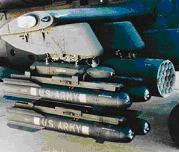
Four AGM-114
Hellfire Missiles Mounted
on a Wing Pylon of an AH-64 Apache Helicopter
Source: US Army
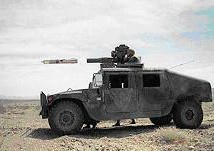
TOW System Mounted on an HMMWV
Source: Thiokol
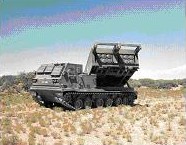
Multiple Launch
Rocket System (MLRS)
Source: Redstone Arsenal
Despite this divergence in policy, Egypt’s
President, Hosni Mubarak, continues to tout his nation as one of America’s
closest allies in the region. That show of fealty has brought enormous financial
rewards. In addition to the $1.3 billion in military assistance Cairo receives
annually from the US, the Bush Administration approved an additional $300
million in aid in 2003 along with $2 billion in loan guarantees, ostensibly to
offset the loss in trade revenue resulting from the Iraq war – a war which Egypt
opposed.
Congress, though, has been less than
sanguine about Egypt’s treatment of the US and Israel in recent years. In
January 2004, Representative Anthony Weiner (D-NY), introduced a bill that would
convert US military assistance to Egypt into economic assistance as a protest
against that country’s growing militancy.
Termed the “Egyptian Counterterrorism
and Political Reform Act”, the bill makes note of Egypt’s failure to halt the
smuggling of weapons contraband across its border with Israeli-controlled Gaza,
its public support of Hizbullah attacks against Israel, the continued incitement
against the US and Israel in the government controlled press, Cairo’s flagrant
abuse of human rights and its refusal to normalize relations with Israel despite
commitments made in the 1979 peace treaty between the two countries.26
In a similar vein, Senator Mitch McConnell
(R-KY),
Chairman of the US Senate Foreign Operations Appropriations subcommittee has
called for the wholesale reform of Egyptian economic and military programs as
well as a halt to its human rights abuses as a pre-condition of future American
assistance.27
In the autumn of 2002, with war against
Saddam just months away, Washington asked the Mubarak Government for
permission to allow American forces access to Egyptian bases.28 Mubarak refused. Yet, just over a year later, Washington agreed to a strategic
dialogue with Cairo aimed at improving US-Egyptian defense ties and bolstering
Egyptian defenses.29
In October, 2002, Egypt conducted the
latest in a series of large scale live-fire exercise in the Sinai Peninsula
designed to test the inter-operability of its modernized air defense capability.30
The 10 day exercise termed “A`asar-2002”, focused on the breakout of the Third
Army across the Suez Canal and through fortifications. According to reports 120
aircraft participated in the exercise which used “reconnaissance and imaging
technology to destroy mock enemy targets”.31
Tanks and armored vehicles were among the targets. Israel, the country with whom
Egypt has a peace treaty, was the presumed adversary.
In recent years, Egypt also has stepped up
its consultations with Syria,32 China, North
Korea and Russia in a bid to boost military cooperation and diversify its
sources of arms.33 The result is an arsenal
bristling with weapons of a clearly offensive character. Among the most
worrisome are 24 No-Dong missiles provided by North Korea. Each can be modified
to carry a nuclear, chemical or biological warhead and has an enhanced range
capable of covering all of neighboring Israel.34
In 1996 Egyptian Chief of Staff
Tantawi declared:
Peace does not mean
relaxation. The endless development of military systems and the arms race
prove that survival is only assured by the strongest and that military
strength will always be necessary. Military strength has grown to be a
prerequisite of peace. Any threat to any Arab or African country is a threat
to Egypt’s national security.35
Enter the Merkava
Israel’s answer to these improvements in
Arab armor is the Merkava main battle tank. First deployed in the late 1970s,
the Merkava, or “Chariot”, is Israel’s only domestically built heavily armored
combat system.
Today, the Merkava forms the backbone of
the Israeli armored fleet with nearly 1,300 vehicles in active service. Its
rugged yet flexible design makes it ideally suited to force-on-force engagements
or use in providing tactical support to Israeli soldiers during times of civil
unrest.36 Eventually, the IDF plans to replace
the country’s entire inventory of aging American-made M-60 (Magach) tanks with
the Merkava.
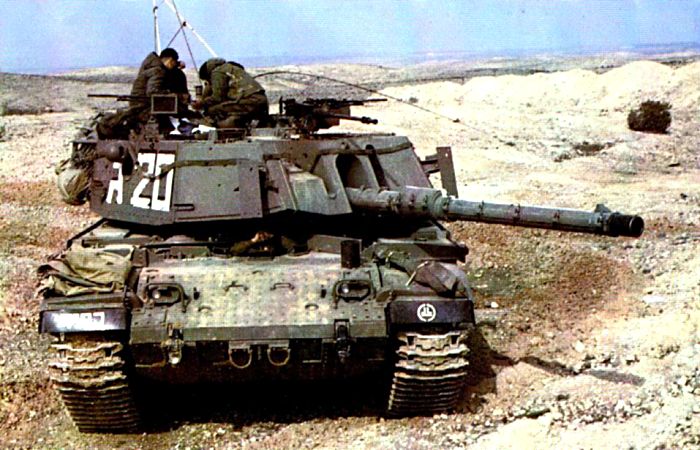
Israel's Magach 7A
Tank; a Variant of the US M60
Source: Daniel Machacek, 2001
The Merkava has undergone four major design
changes since its introduction into the country’s order of battle. In its most
modern configuration, the Merkava Mk 4 was introduced into the IDF in the
summer of 2003. The tank boasts a stabilized gun platform, advanced suspension,
a high velocity smoothbore 120mm gun, full night fighting capability, individual
air conditioning, a state-of-the-art fire control system, a 10 round
electrically operated magazine, and an upgraded GD883 V-12 engine rated at 1,500
hp.
The main gun can fire an array of
ammunition to include 120mm kinetic, HEAT and anti-personnel rounds as well as
the Israeli-developed Lahat, a tandem warhead missile designed to defeat armored
vehicles shielded with reactive armor.
In the view of many of the world’s armor
experts, the 65 ton Merkava is equal to, or better, than any of its rivals. It
also is considered to be among the “best protected tanks in the world”.37
Its advanced modular armor system protects the vehicle against the “penetration
of APFSDS (Armor Piercing Fin Stabilized Discarding Sabot) shells and all known ATGMs”. Extra plating shields the turret from top-down attack.38
So confident is the IDF in the
survivability of the Merkava that it has indicated a willingness to retire two
of its older armored vehicles for every Merkava tank it procures.
The Merkava is the brainchild of Israel’s
legendary tank designer, General Israel Tal, who not only sought a highly
maneuverable multi-role armored vehicle, but also one which placed a premium on
crew survivability. For added protection, the vehicle’s
engine is mounted forward of the crew compartment
while its ammunition is stored towards the rear for better protection.
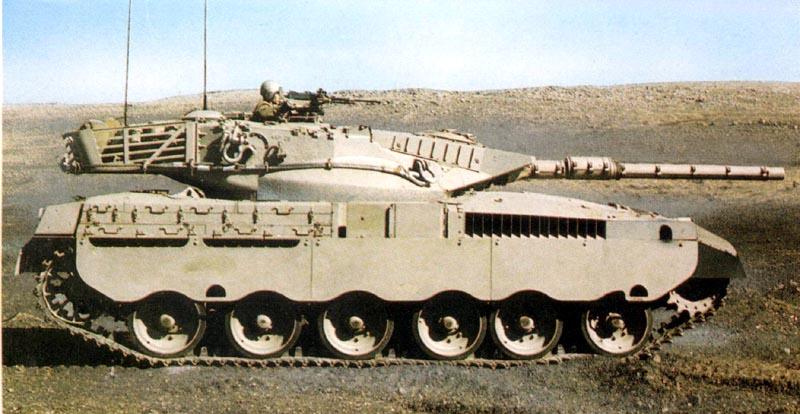
Merkava MK1. First Production Model.
The tank first saw battle during the 1982 Peace for Galilee Operation.
Source: Israel Defense Forces
Unlike other main battle tanks, the Merkava
doubles as a troop transporter. Its rear entry design enables up to eight fully
equipped soldiers to be carried safely into combat. A 60 mm mortar mounted
inside its hull along with three 7.62 mm machine guns permits the crew to
provide suppressive fire at close range while also using its main gun to deliver
precision strikes against fortified enemy positions.39
This was proven in April 2002, during
Operation Defensive Shield when the IDF employed Merkava tanks to dislodge
Palestinian terrorists holed up in the fortified concrete buildings in the Jenin
refugee camp.40 The Merkava was the weapon of
choice for military commanders concerned that the use of F-16 aircraft and
artillery to destroy terrorist positions would risk unacceptable collateral
damage and lead to a high loss of civilian life within the densely packed
refugee camp.41 Since the collapse of the Oslo
process in September 2000, the Merkava has successfully supported Israeli
military operations throughout the West Bank and Gaza.
Even as the Merkava has significantly
bolstered Israel’s security, the presence of large numbers of the American M1
Abrams tanks in the hands of a well-trained enemy could alter the strategic
equation in the region. Used in conjunction with advancing artillery, close air
support and missiles armed with chemical
or biological warheads, the M1 could
present the IDF with a situation it has never before faced – near parity in
offensive armored systems.
To address this challenge, the Merkava
incorporates the Amcoram LWS-2 laser warning system that allows a commander to
detect and track the launch of incoming missiles. Its survivability is further
enhanced by the incorporation of a positive pressure crew cabin to protect
against an external NBC threat. Four cameras mounted in hardened recesses on the
hull afford the commander a 360 degree panoramic view of the tank’s surroundings
under both day and night conditions.
The Merkava is the centerpiece of Israel’s
three regular and nine armored divisions. It is the principal instrument through
which IDF ground commanders are able to implement Israel’s version of lightening
war, a doctrine which calls for the IDF to win all of its battles quickly and
decisively and with the fewest possible casualties.42
When fully mobilized, Israel is able to increase its armored strength from 20 to
33 brigades enabling the country to simultaneously defend against ground attack
along each of its borders.
Targeting for the Merkava’s main gun is
carried out by a ballistics computer and aided by an advanced forward looking
infrared (FLIR) system. Developed by El-Op, it can operate under all weather and
light conditions.
The debate over the Merkava has its
corollary in the recent decision of the IDF to acquire the American-made Stryker
LAV-3, a lightly armored personnel carrier (APC) that is to replace its older
M-113A1 and M-113A2 APCs. Weighing in at 19 tons and with a maximum speed of 62
mph, the Stryker sacrifices lethality and protection for speed. It operates on
eight
wheels instead of tracks and can travel for miles even when all of its tires are
flat.
Following the lead of the US Army, the IDF
sought a combat transport vehicle that could deliver soldiers to the battle
front with greater maneuverability than current APCs while also being able to
operate in the crowded urban terrain of the West Bank. The IDF plans to buy 500 Strykers for $750 million.43
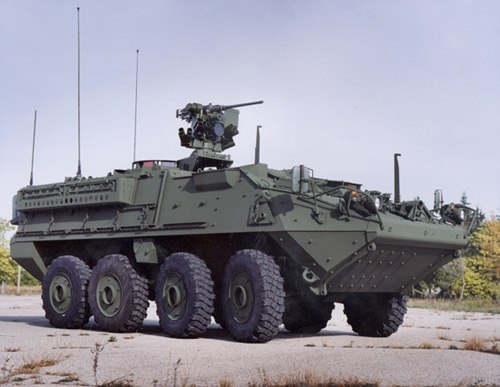
Stryker: US Army's
Interim Combat Vehicle
Source: US Army
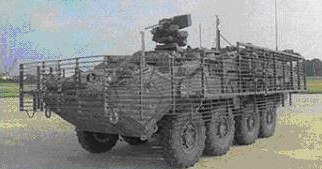
Stryker in Iraq,
Retrofitted with "Slat" Armor
for Added Protection against RPGs
Source: Free Republic
Proponents of heavy armor note that the
Merkava is optimized for just these conditions while also having the ability to
insert troops into hostile environments under the safest and most comfortable
conditions possible. In past years, the IDF had rejected the Bradley Fighting
Vehicle (BFV), another lightly armed combat system, in large part because it
lacked sufficient armored protection.44
Unlike the Merkava, the Stryker lacks
a powerful gun, is vulnerable to RPGs and IEDs and has no air conditioning, an
important consideration when desert temperatures can often soar above 110
degrees in the vehicle. Its skin is composed of steel and aluminum and is covered
with 130 protective tiles. The US first deployed a Stryker brigade to Iraq in
October, 2003. Two months later, on December 14th, the Stryker’s
vulnerability was demonstrated when an IED destroyed one vehicle in an attack
near Ar-Ramadi.
The IDF is anxiously monitoring the
Stryker’s performance in Iraq knowing that its success or failure will be
influential in the debate over what type of armored force will be most useful
for Israel in the years to come.
Challenges Facing Israel
While the Merkava represents the pinnacle
of heavy armor systems, its future as an ongoing industrial concern remains in
doubt. Faced with the effects of a deep recession, a severe drop in government
revenue and the rising cost of the Palestinian war, advisors to Israel’s Prime
Minister, Ariel Sharon, have argued that the program has simply become
unaffordable and must be scrapped.
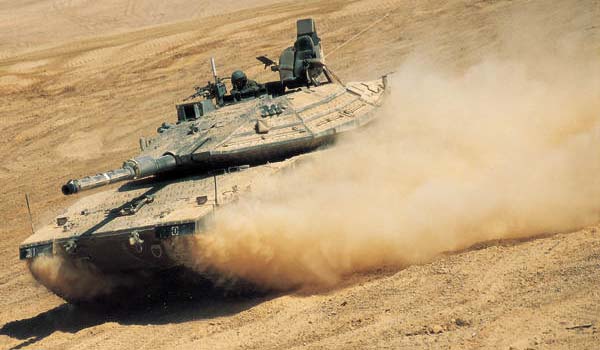
Israel's Merkava MK4 Main Battle Tank
Source: Israeli-Weapons.com
The first hint of trouble came during the
summer of 2003 as Israel’s Ministry of Finance was preparing its FY 2004 budget
proposal. At that time the Treasury recommended a reduction in defense
expenditure of approximately NIS 7.1 billon or $1.6 billion. The Ministry of
Defense countered that a decrease of this magnitude would break the back of the
IDF by forcing the cancellation of critical programs and hasten the drastic
cutback in the Army’s operational tempo at a time of national emergency.
Israel’s General Staff argued that even a reduction of NIS 3 billion ($684
million) was unacceptable.
With little room to maneuver, officials at
the Finance Ministry, supported by those in the IDF Planning Branch, proposed
halting the manufacture of the Merkava tank as a way of slowing the country’s budgetary
hemorrhage. Their recommendation reflected a growing split within the ranks of
the military over whether the growing lethality of modern anti-tank weapons was
in fact making heavy armored vehicles obsolete.
By one estimate, eliminating the Merkava
program would save the IDF less than NIS $1 billion annually, roughly $220
million, or about the amount spent each year on the acquisition of 50 tanks.
The effect on the Israeli economy as a
whole would be far more significant with the cost in unemployment, missed
investment, lost exports, and curtailed research and development reaching,
perhaps, into the billions of dollars. Indeed, the
negative economic effects could well exceed those of the cancelled Lavi fighter
program nearly two decades ago.
Defense is one of the principal engines of
the modern Israeli economy and military R&D is often the catalyst for innovation
in the civilian sector. Products derived from defense research form the basis
for much of the country’s high technology exports. Without the Merkava, the
industrial base will lose an important infusion of technical know-how and
investment.
In yet, another sign of growing military
austerity, the Israeli MoD has eliminated funding for all new R&D projects in
its FY 2004 defense budget. This is a direct
result of a cut in overall military
expenditure of NIS 3 billion (US$680 million).45
Speaking at the Herzliya Conference in
December 2003, Yaakov Sheinin, CEO of
Economic Models Israel
noted the
enormous impact of defense on the Israeli economy.
Every dollar in Ministry of Defense orders
produces $2.40 in defense exports, which have an added value of 66%. If the
economy emerges from the recession with five percent growth in 2004, it will
take until 2010 before employment falls to six percent. For every public sector
worker they want to fire, the private sector wants to fire two.46
Critics of the plan to scuttle the Merkava
have been quick to rally in support of its continued production. Former Defense
Minister, Moshe Arens observed:
Developing a new fighter aircraft at this time
will take more resources than Israel could possibly afford. It might be done if
another partner could be found for the project. As for the Merkava,
it is the best main battle tank in the world and its production should certainly
not be stopped.47
According to the Israel Manufacturers
Association (IMA), the Merkava program is responsible for between $200 million
and $250 million in annual defense technology exports. This is in addition to
the $688 million Israeli industry is slated to receive from the Government of
Turkey for the upgrade of 170
M60A1 tanks. The potential exists for this number to rise to 900 Turkish
tanks, but only if the Merkava project is kept alive.48
Terminating the Merkava line would end any
hope of future overseas tank sales as well as the possibility of co-production
and licensing agreements on related technology. The shock to Israel’s defense
industries would be enormous, compounding an already serious decline in overseas
orders. In 2003, the country’s military exports fell by 37% from their high just
the year before.
At the present time, 220 companies supply
subcomponents to the IDF, the Merkava’s prime contractor. Of these firms, all
but a handful are Israeli. Approximately 22% of the Merkava’s content is of
American origin.
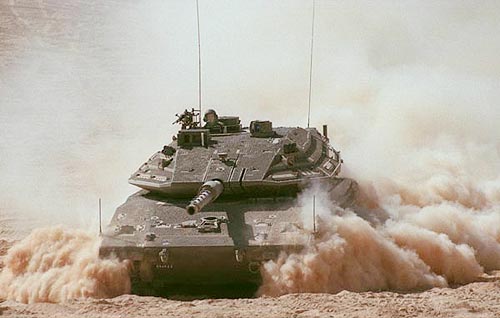
Israel's Merkava MK4 Main Battle Tank on Maneuvers
Source: Israeli-Weapons.com
In the event of a shutdown, between 6,500
and 10,000 workers could lose their jobs. Many of the affected companies reside
in development towns across Israel – from Kiryat Shemona in the north to Mitzpeh
Ramon in the south – where unemployment is high and the effects of the current
recession have hit hard.
It is unlikely that many of these workers,
many skilled in metal fabrication, electronics and systems integration, will
find alternative employment in a country already suffering from a saturated
labor market and massive cutbacks in its industrial sector. As a consequence, a
large number may seek jobs overseas, accelerating the flight of Israel’s
intellectual capital, slowing external investment and worsening the country’s
prospects for an economic recovery.
Many current and former IDF commanders have
criticized the government’s budget plan, noting that what is happening to the
Merkava is merely emblematic of a growing erosion in Israel’s overall national
security posture.
“These are unacceptable tradeoffs,”
observed Maj. Gen. Haim Erez (Res.).
The Merkava is the principal vehicle the
military has to seize and hold ground. Its design reflects decades of
operational experience, experience gained at a very high cost in lives and
money. Important, as well, is the fact that the effect of closing the program
will be felt throughout country’s defense industrial base. Israel’s economy will
suffer irrevocable damage as a result.49
Erez and his brigade were the first to
cross the Suez Canal during the 1973 Yom Kippur War in hot pursuit of the
retreating Egyptian Army.
Since its inception, Israel has spent
upwards of $6.5 billion in developing and acquiring the Merkava.
With the future of the Israeli tank program
in limbo, the MoD has shelved plans to develop the next generation armored
vehicle, the Merkava 5. Reports emanating from the IDF hint that the Army was
considering replacing the Merkava’s tracks with wheels in an effort to make it
faster, lighter and, in the view of some experts, more maneuverable.
Ultimately, though, salvation for the
Merkava may come about through the privatization of the main production line.
Talks are now underway between Israel Military Industries (IMI) and Urdan
Industries to purchase the Government’s interest in the program. An Urdan
subsidiary, Associated Steel Foundries of Netanya, is responsible for casting
many of the armored portions of the tank to include the turret, hull, tracks and
suspension. If concluded, this deal would permit the restructuring of the
program and the possibility of overseas sales.
Whether on the battlefield or in the
marketplace, the future success of the Merkava rests, for the foreseeable
future, on the commitment of the Israeli government to continue to modernize its tank
inventory. This means not only will Jerusalem need to make an ongoing investment
in tank technology, but it also must ensure that an economic rate of production
is maintained as well.
It takes approximately 30 months for a
fully operational Merkava tank to be assembled. Any hiatus in production funding
could have significant economic consequences for the companies responsible for
the program. Many have placed orders for long lead items with some, like the
American-made engine, extending out three years. Contract termination penalties
could run into the hundreds of millions of dollars.
At present, the IDF has
booked orders for the Merkava through 2007. With the current industrial base that will
require that the country manufacture between 60 and 70 Merkava Mk 4 tanks per
year. At this relatively modest rate of production and given Israel’s current
number of tanks that would means that a vehicle built today can be expected to
have a service life of between 50 and 80 years. By any reasonable standard, this
is an excessive amount of time for the fielding of a ground combat vehicle.
Abrams Alternative for Israel?
In place of the Merkava, some Israeli
government officials have suggested that Israel should consider adopting the
American M1 Abrams as its primary MBT. They argue that this would help to
standardize US and Israeli equipment and, in theory, allow Israel to divest
itself of a costly production line. An arrangement of this sort would probably
rest on an American commitment to allow Israel to incorporate its own
proprietary technology in its tanks.
Israel’s Finance Minister, Benjamin
Netanyahu, has lent his support to this idea and suggested further that the tanks
be paid for with the military assistance Jerusalem receives annually from the
US.50 With the recent defeat of the Iraqi army
and the removal of Saddam Hussein from power, Netanyahu contends that Israel no
longer needs such a large standing armor force to protect the country’s eastern
frontier.
Even so, there are at least six principal
reasons why Israel’s adoption of the Abrams M1 tank is impractical and, at the
present time, has little chance of succeeding.
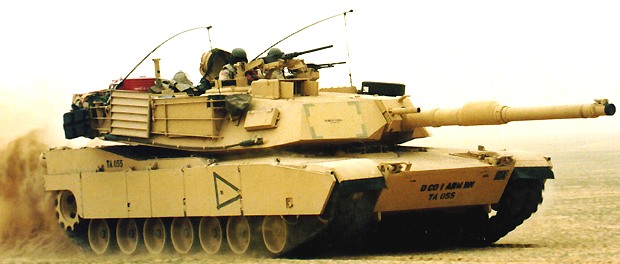
A US Army Abrams M1A1 MBT in the Kuwaiti Desert
Source: SPG Media Ltd., 2004
First, the prime contractor for the M1,
General Dynamics Land Systems, no longer maintains a manufacturing line for the
tank. Restarting full-scale production at its Lima, Ohio facility would simply
be too costly and too impractical. It is more than likely the Pentagon would
oppose such a move as it focuses on developing a successor to the Abrams.
Second, the base cost for the M1 Abrams
tank is approximately $8-9 million against the cost of a new Merkava at
approximately $4-5 million. This price difference puts the Abrams out of reach
of the current Israeli defense budget plan.51
Third, a new heavy weapon system requires a
large support infrastructure for maintenance and repair. Here again cost is a
factor. Israel simply can not afford to have two parallel logistics tails for
its tank inventory. Besides the expense, it would only add to the difficultly of
providing fast and efficient support to armored units in wartime.52
Fourth, a well oiled production
infrastructure for the Merkava allows Israeli commanders to requisition spare
parts on an as-needed basis. Equipment lightly damaged in combat can be repaired
and quickly to returned to the field.
Fifth, Israel has learned through hard
experience that reliance on a foreign source of supply for spare parts for its
military significantly inhibits the country’s freedom of political action. With
dependency comes control. Successive generations of Israeli leaders have tried
to improve the self-sufficiency of the country’s military to lessen the amount
of leverage any third party has on the conduct of its foreign and military
policy.
At present, a joint venture between the
German firm MTU and GDLS is responsible for the production of the Merkava’s
GD883 diesel engine and Renk RK325 automatic transmission in the US. This had to
be done to circumvent an arms embargo imposed by Germany on Israel for its
actions taken in its war with the Palestinians.
Sixth, any Israeli purchase of Abrams tanks
would have to be made in dollars. Israel relies heavily on dollar denominated
foreign exchange for the purchase of essential overseas items from the US dollars are precious Treasury assets and always in short supply.
For the time
being, most of Israel’s military assistance dollars are committed to other
priority acquisition programs.
Either Israel would have to make funds
available out of its shrinking national budget to pay for the imported tanks – a
costly option – or it would have to earmark a portion of its US foreign
assistance for that purpose. Which ever choice Jerusalem would make, the
procurement would place an undue strain on the country’s finances and displace
other high-ticket programs vital to Israel’s national security.
Another advantage conferred by local
Merkava production is that Israel is able to finance much of its current content
using a portion of the US military aid package designated as Offshore
Procurement (OSP). These are funds that can be converted into shekels and spent
locally in Israel. Of the $2.33 billion in military
assistance provided by the US to Israel in 2004, $565 million, or 26%, may be
used for Offshore Procurement.53
These funds are critical to helping to maintain a strong defense industrial base
in Israel.
Even as the fate of the Merkava was being
decided, the IDF decided to go ahead with the decision to purchase the Stryker
armored vehicle. Cash starved and forced to cut back on essential training, the
Army nonetheless decided that it had the funds to launch an entirely new
procurement program. The $750 million price tag for the Stryker is to be paid
for using scarce US foreign assistance dollars.
Whereas most funds
spent on the Merkava are used domestically to boost the Israeli economy, those
spent on the Stryker are returned to the US and the prime contractor for the
system, General Dynamics.
Adopting a foreign weapons system as
important to Israel’s national defense as is the heavy tank would run contrary
to the goals of successive governments. With the harsh lessons of the 1973 Yom
Kippur War still fresh in the minds of many Israelis, few would have an interest
in returning to a time when Washington was able to stop an advancing Israeli
Army dead in its tracks simply because it controlled the supply of spare parts.
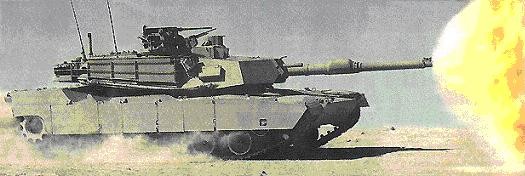
M1A2 Main Battle Tank firing its M256 main gun, a 120 mm smoothbore gun
developed by Rheinmetall GmbH of German
Source: SPG Media, Ltd., 2004
Another possibility is that Israel would
agree to exchange technology contained in the Merkava tank for a place on the
American team developing the replacement for the Abrams M1-A2 tank. Presumably
Israel would then have the right to supply components for the project and
eventually acquire the new vehicle, in quantity, for its own fleet.
According to reports that surfaced in late
2003, this idea was broached in talks between James Albaugh, the President of
Boeing Integrated Defense Systems, and Maj. Gen. Yiftah Ron Tal, Commander of IDF Ground Forces.54 Boeing is spearheading the
effort to design a new armored system as part of the Army’s Objective Force
strategy scheduled to become operational by 2010. The Future Combat Systems
program is intended to develop vehicles that are lighter, highly maneuverable
and more lethal than traditional heavy tanks while also being air transportable.
It may be some time before the Pentagon
decides if it will be allowed Israel to participate in new DoD effort. Equally
uncertain is whether the specifications for America’s future tank will coincide
with Israel’s requirements. The IDF, for instance, has no need to sacrifice
armor protection for air deployability.
Israel’s Worsening Budget Dilemma
The fact remains that the IDF has found it
impossible to fund many of its priority programs, not only the Merkava.
Equipment maintenance, training, the purchase of spare parts, research and
development (R&D), and the acquisition of new weapons
platforms have all been slashed in a bid to pay for current operations and
personnel costs. This state of affairs has become so severe that the IDF
announced at the start of 2004 that Army reservists would soon be training
without live ammunition because funds simply were not available to make the
necessary purchases.55
In some cases, reserve armor units have not received live training ammunition
for the past three years.
The situation is the same in the Navy and
Air Force where patrolling and flying hours also have been cut in an effort to
reduce training costs.56 According to one
report, the IDF is planning “to rent one of its training facilities to friendly
foreign armies” as one way of raising much needed revenue.57
This dramatic fall off in readiness has led
some military observers to conclude that the country is as ill prepared for
general war as it was in the months prior to conflict in 1973. If true, this is
a startling revelation and one which argues strenuously for an increase in
current Israeli defense spending. Commented Shaul Mofaz, the country’s Defense
Minister, “it could be that the security situation in 2004 will be worse than it
is now because of the fact that we will be unable to provide a security response
to threats.”58
In FY 2002, Israel’s defense spending was
cut by NIS 7 billion. In FY 2003 the reduction was NIS 2.25 billion.59
Today, Israel’s overall defense budget stands at roughly NIS 35.2 ($8.0 billion)
or about seven percent of GDP. By contrast, in 1984 Israel’s defense budget
stood at $11.3 billion or 24.5% of GDP.60 In
2004, approximately 13% of Israel’s state budget will be devoted to defense.
Additionally, the Ministry of Defense is
spending an estimated NIS 2 billion ($460 million) annually to quell the
Palestinian uprising.61 This figure does not
include the cost of constructing Israel’s security barrier or large scale
mobilizations like Operation Defensive Shield.
The Tank’s Tumultuous Future
For the foreseeable future, it would appear
the tank’s place on the modern Middle Eastern battlefield is secure. Yet, like
all military systems it will have to continue to evolve. A renaissance in heavy
armored systems may yet mark the tank’s future.
For the Israel soldiers who fought in the
Yom Kippur war of 1973, the tactical importance of the tank was proven
convincingly on both the Egyptian and Syrians fronts. After being routed from
their positions along the Suez Canal following Egypt’s surprise attack, a
battered Israeli army recovered from near defeat by employing superior armored
tactics backed by air cover. By the time the US brokered ceasefire took hold,
the Egyptian Third Army had been surrounded and its 45,000 men and 250 tanks
threatened with annihilation.
There are many lessons to be drawn from
this experience. The first of these is that Israel must not significantly
sacrifice quantity for quality in planning for future ground combat scenarios.
While there are many factors that contribute to victory in war – training,
tactics, superior equipment – it is also a fact that combat can not be sustained
on a high attrition battlefield without a sufficient reserve of men and
equipment.
Second, a robust industrial base for armor
should be maintained to support not only peacetime developmental efforts, but
also to serve as a source for the rapid delivery of spare parts and maintenance
activity in wartime.
Of the 2,000 tanks fielded by Israel during
the 1973 war, 400 were destroyed in combat. Many more were damaged, repaired and
returned to the fighting. By contrast, Egypt lost half of its armored force or
1,100 tanks out of an inventory of 2,200. Syrian losses amounted to 1,200 tanks
out of 1,820 pressed into service.62
As Israel’s economic situation weakens,
that of the Arab World appears to be improving. According to one economic
forecast, GDP in the Middle East and North Africa could reach 3.4% in real
growth in 2004.63 By contrast, Israel will be
lucky to achieve a 2.0% increase in its GDP during the same period. With a
growth rate of only 0.7% in 2003, Israel was ranked 24th out of 25
emerging economies by the British magazine,
The Economist.64
At the same time, military
spending throughout much of the Arab World
continues to grow.
If this trend persists, the Jewish state
could find itself matched by its potential enemies in both the quality and
quantity of military equipment at their disposal. This could pose a serious
readiness problem for a country that has striven, since 1967, for
self-sufficiency in most areas of its national defense.
And what does the future hold for the
Merkava? In a meeting with managers and workers at one of the main Merkava
facilities on December 23, 2003, Israeli Defense Minister Shaul Mofaz announced
that for the time being tank production would continue.
The Merkava is “vital to Israel’s
security”, he declared. “This is the flagship of the ground-based projects. This
project, like the rest of the defense industries, is an important strategic and
technological base for Israel and we can’t harm it.”65
Mofaz’s comments were echoed by the
Director General of Israel’s Ministry of Defense, Maj. Gen. Amos Yaron (ret.).
“This tank will continue to be built. Perhaps there will be difficulties in the
coming year; and perhaps we may need to decrease the number of tanks to be
produced, but this project will not stop. I repeat, this project will not end.”66
Addressing the role armor might play in the IDF of the future Yaron added: “The requirement for tanks remains, and the
requirement for the quality represented by the Merkava Mk 4 remains unchanged.
It is not possible to settle for less quality, and therefore this tank will
continue to be built.”67
These are certainly reassuring words to the
thousands of soldiers and workers whose lives and livelihoods depend upon
Israel’s commitment to heavy armor. Yet, without a new national consensus in
Israel on the need for increased defense expenditure, the upbeat assessment of
both Mofaz and Yaron may amount to little more than wishful thinking.